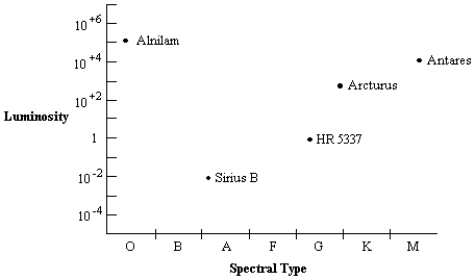Correct Answer

verified
Correct Answer
verified
Multiple Choice
The most accurate way to determine the surface temperature of a star is to study
A) the pattern of absorption lines from various atoms.
B) the relative intensities of light measured through different photometric filters.
C) the peak wavelength of the star's continuous blackbody spectrum.
D) pattern of emission lines that are on the star's spectrum.
Correct Answer

verified
Correct Answer
verified
True/False
An M star is hotter than an O star.
Correct Answer

verified
Correct Answer
verified
Multiple Choice
If you compare two stars,
A) the one with the larger radius will always have the greater luminosity.
B) the one with the higher surface temperature will always have the greater luminosity.
C) the one with the smaller absolute magnitude will always have the greater luminosity.
D) the one with the larger surface area has the greater energy flux from its surface.
Correct Answer

verified
Correct Answer
verified
True/False
The densest stars in the H-R diagram are the white dwarfs.
Correct Answer

verified
Correct Answer
verified
Multiple Choice
A star's luminosity depends only on the star's
A) distance and diameter.
B) temperature and distance.
C) distance.
D) temperature and diameter.
E) apparent magnitude.
Correct Answer

verified
Correct Answer
verified
Multiple Choice
The correct sequence of spectral type letters from hot on the left to cool on the right is
A) M, K, G, F, A, B, O
B) O, B, A, F, G, K, M
C) G, K, M, F, O, B, A
D) A, B, O, F, G, K, M
Correct Answer

verified
Correct Answer
verified
Multiple Choice
If two stars are emitting the same amount of light, the star that is farther will appear
A) brighter.
B) dimmer.
C) redder.
D) bluer.
E) They will have the same brightness as seen from Earth.
Correct Answer

verified
Correct Answer
verified
Multiple Choice
In the H-R diagram, 90 percent of all stars are
A) in the giant region.
B) in the supergiant region.
C) among the B stars.
D) among the G stars.
E) on the main sequence.
Correct Answer

verified
Correct Answer
verified
True/False
Giant stars are members of luminosity class III.
Correct Answer

verified
Correct Answer
verified
Multiple Choice
A star's apparent magnitude is a measure of ...
A) how bright it appears to us if it is at its actual distance.
B) how bright it appears to us at a standard distance of 10 pc.
C) its energy output per second compared to the sun.
D) its mass in solar masses.
E) its surface temperature in Kelvin.
Correct Answer

verified
Correct Answer
verified
Not Answered
How does density divide the stars in the H-R diagram into three groups?
Correct Answer

verified
Correct Answer
verified
Multiple Choice
Table 8-1
Use the chart below to answer the following question(s) .
 -From the data given,, which star in Table 8-1 has the greatest luminosity?
-From the data given,, which star in Table 8-1 has the greatest luminosity?
A) 65 Tau
B) HR 4621
C) ( Pic)
D) 58 Ori
E) HR 2491
Correct Answer

verified
Correct Answer
verified
Not Answered
How do absolute visual magnitude and luminosity differ?
Correct Answer

verified
Correct Answer
verified
Multiple Choice
Vega is an A0 V star. Based on this information, which of the following are true? 
A) I & II
B) II & III
C) II, III, & IV
D) I, II, & III
E) I, II, III, & IV
Correct Answer

verified
Correct Answer
verified
Multiple Choice
Table 8-1
Use the chart below to answer the following question(s) .
 -From the data given, which star in Table 8-1 is the closest to Earth?
-From the data given, which star in Table 8-1 is the closest to Earth?
A) 65 Tau
B) HR 4621
C) ( Pic)
D) 58 Ori
E) HR 2491
Correct Answer

verified
Correct Answer
verified
Short Answer
For stars on the main sequence, the luminosity can be estimated by the formula L = ____________________.
Correct Answer

verified
Correct Answer
verified
Multiple Choice
The mass of a visual binary pair of stars can be obtained from
A) the time in years for them to orbit one another.
B) the size of their orbit.
C) their apparent magnitudes.
D) both A and B
Correct Answer

verified
Correct Answer
verified
Multiple Choice
The star named Sheat is of M2 II spectral type and luminosity class. Based on this information, which of the following are true? 
A) I & II
B) II & IV
C) II, III, & IV
D) I, II, & III
E) I, II, III, & IV
Correct Answer

verified
Correct Answer
verified
Multiple Choice
Diagram 8-1
Use the H-R diagram below to answer the following question(s) .  -Which star in Diagram 8-1 is most like the sun?
-Which star in Diagram 8-1 is most like the sun?
A) Alnilam
B) Antares
C) Arcturus
D) HR 5337
E) Sirius B
Correct Answer

verified
Correct Answer
verified
Showing 41 - 60 of 133
Related Exams